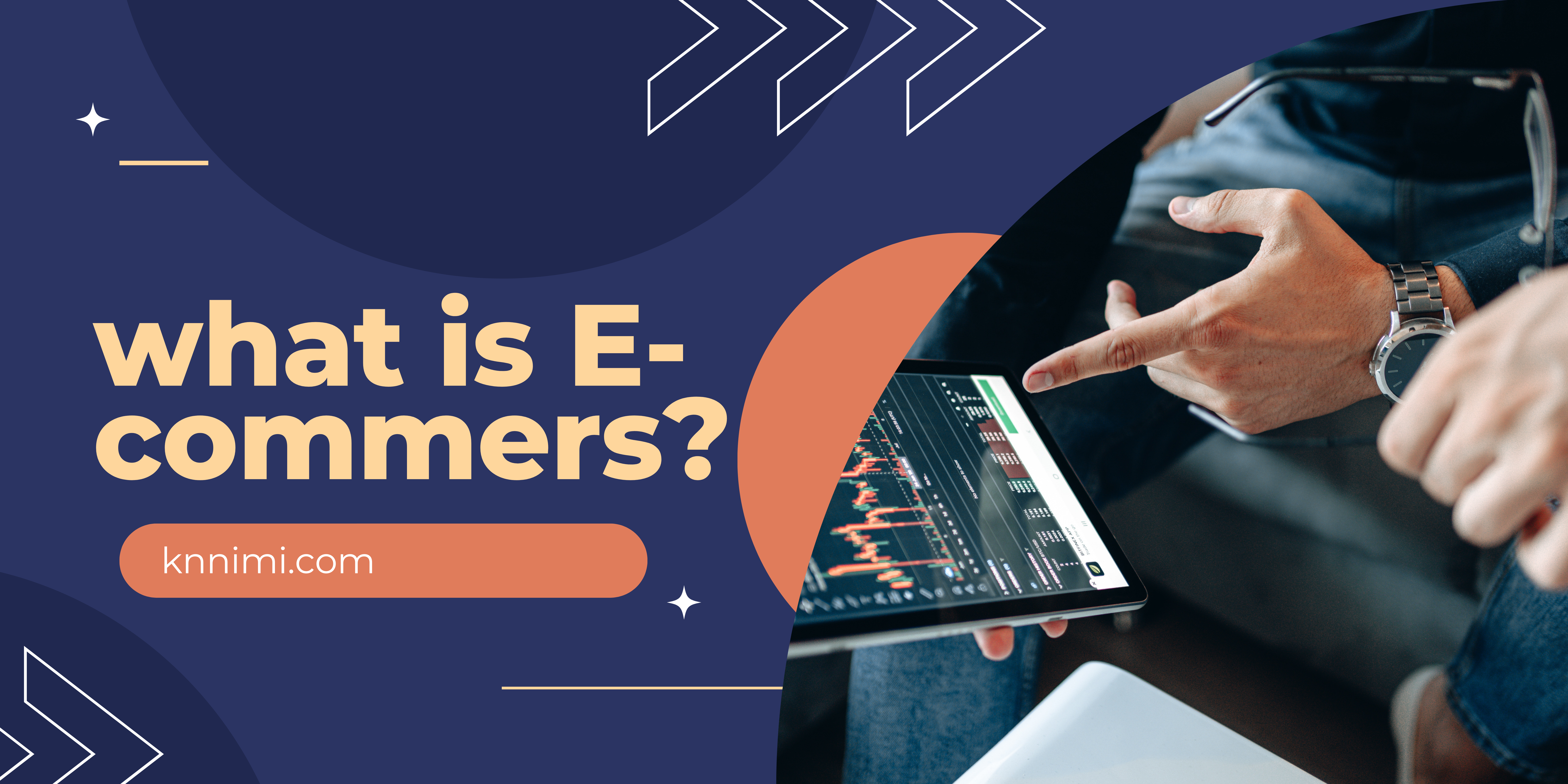What is E-commerce? In the ever-evolving landscape of commerce, e-commerce stands as a formidable titan, revolutionizing how we buy and sell goods. This comprehensive guide delves into the multifaceted realm of e-commerce, unraveling its complexities and illuminating its evolution.
Defining E-commerce
At its core, e-commerce, or electronic commerce, is the digital exchange of goods and services. It transcends geographical boundaries and physical storefronts, enabling transactions to occur seamlessly in the virtual realm.
Evolution of E-commerce
E-commerce’s roots trace back to the 1960s when electronic data interchange (EDI) emerged, allowing businesses to exchange documents electronically. The true catalyst, however, was the advent of the World Wide Web in the 1990s, paving the way for online shopping as we know it today.
The Mechanics of E-commerce
Diving into the Components
- Online Storefronts
- Online storefronts are the digital facades of businesses, serving as the point of entry for customers. They showcase products, offer essential information, and create a captivating shopping experience.
- Shopping Carts
- Shopping carts are the virtual baskets that hold our desired products. They allow customers to browse, select items, and easily proceed to checkout.
- Payment Gateways
- Payment gateways are the digital cashiers, securely processing transactions by connecting online stores with financial institutions. They facilitate payments using various methods.
- Product Databases
- Product databases are the treasure troves of information and housing details about available items. They provide customers with crucial data, from specifications to prices.
- Security Protocols
- Security protocols are the guardians of e-commerce, ensuring that sensitive information such as credit card details remains confidential. They employ encryption and authentication to protect data.
Exploring E-commerce Models
- B2B (Business-to-Business)
- B2B e-commerce involves businesses selling products or services to other companies. It streamlines procurement processes, enhancing efficiency in the corporate world.
- B2C (Business-to-Consumer)
- B2C e-commerce connects businesses directly with consumers. It’s the realm of online shopping that most of us are familiar with, offering a vast array of products and services.
- C2C (Consumer-to-Consumer)
- C2C e-commerce allows individual consumers to trade with one another. Platforms like eBay and Etsy thrive in this model, empowering individuals to become online entrepreneurs.
- C2B (Consumer-to-Business)
- C2B e-commerce flips the traditional model, as consumers offer products or services to businesses. Influencers, freelancers, and gig economy workers often operate within this framework.
E-commerce Platforms
Unveiling the Giants
- Shopify
- Shopify provides a user-friendly, all-in-one solution for e-commerce businesses. Its simplicity makes it a favorite among entrepreneurs.
- WooCommerce
- WooCommerce, a plugin for WordPress, offers versatility and customization. It’s an ideal choice for businesses seeking a tailored online presence.
- BigCommerce
- BigCommerce focuses on scalability and performance. It’s suitable for growing enterprises with ambitious e-commerce goals.
- Magento
- Magento is the powerhouse for large-scale e-commerce operations. Its robust features cater to enterprise-level businesses.
- Wix
- Wix combines website building with e-commerce capabilities. It’s perfect for those who desire creative freedom.
Choosing the Right E-commerce Platform
- Factors to Consider
- Budget: Assess your financial constraints.
- Scalability: Plan for future growth.
- Customization: Match the platform with your brand.
- Ease of Use: Evaluate your team’s technical expertise.
Case Studies: Success Stories on Different Platforms
- Explore real-life examples of businesses thriving on different e-commerce platforms.
Setting Up Your Online Store
Foundation for Success
- Domain Selection
- Choose a memorable and relevant domain name for your e-commerce venture.
- Website Design and Layout
- Craft a visually appealing site with user-friendly navigation, responsive design, and mobile optimization.
- Content Management
- Populate your site with engaging product listings, informative descriptions, high-quality images, and customer reviews.
- Inventory Management
- Implement effective strategies for tracking stock, managing variants, and addressing out-of-stock items.
- Pricing Strategies
- Employ competitive pricing, psychological pricing, and strategic discounts and promotions.
Payment Processing
Seamless Transactions
- Payment Gateway Options
- Explore popular payment gateways like PayPal, Stripe, Square, and Braintree.
- Ensuring Payment Security
- Safeguard transactions with SSL certificates, PCI compliance, and fraud prevention measures.
E-commerce Marketing Strategies
Driving Visibility and Sales
- SEO for E-commerce
- Master keyword research, on-page optimization, and link-building techniques.
- Content Marketing
- Harness the power of blogging and video marketing.
- Social Media Marketing
- Leverage platforms like Facebook, Instagram, Twitter, and LinkedIn, and collaborate with influencers.
- Email Marketing
- Build subscriber lists and execute effective drip campaigns.
- Paid Advertising
- Dive into Google Ads, Facebook Ads, and retargeting campaigns to boost visibility.
User Experience (UX) and Conversion Optimization
Crafting the Perfect Shopping Journey
- The Importance of UX
- Understand why user experience is paramount.
- A/B Testing
- Continuously improve by testing variations of your site.
- CRO (Conversion Rate Optimization)
- Optimize your site to convert visitors into customers.
- Implementing Trust Signals
- Build trust through reviews, security badges, and social proof.
- Streamlining Checkout Processes
- Make checkout effortless to reduce cart abandonment.
Logistics and Shipping
Shipping in the Digital Age
- Shipping Options
- Discover the various shipping methods available, including standard, expedited, and international shipping.
- Shipping Cost Calculations
- Learn how to calculate shipping costs accurately, factoring in dimensions, weight, and destination.
- Tracking and Notifications
- Enhance customer satisfaction by providing order tracking and timely notifications.
- Returns and Refunds
- Establish clear policies and procedures for handling returns and issuing refunds, fostering customer trust.
E-commerce Legal Considerations
Navigating the Legal Landscape
- Privacy Policies
- Craft comprehensive privacy policies that safeguard customer data and comply with regulations.
- Terms and Conditions
- Create clear and concise terms and conditions that govern user interactions with your e-commerce platform.
- Compliance with Consumer Protection Laws
- Ensure compliance with laws governing consumer rights, including warranties, refunds, and product descriptions.
- Handling Customer Data
- Implement robust data protection measures to safeguard customer information, addressing concerns about data breaches.
Customer Support and Engagement
Delivering Exceptional Service
- Providing Excellent Customer Service
- Explore strategies for delivering top-notch customer support, from live chat to responsive email support.
- Live Chat and Chatbots
- Leverage live chat and AI-powered chatbots to enhance customer interactions and efficiency.
- Managing Customer Reviews and Feedback
- Effectively manage online reviews and feedback to build credibility and improve your products and services.
Scaling Your E-commerce Business
Expansion and Growth
- Expanding Product Lines
- Strategically diversify your product offerings to cater to a broader customer base.
- Entering New Markets
- Explore opportunities to enter new geographic markets, tapping into a global audience.
- Collaborations and Partnerships
- Forge partnerships and collaborations with other businesses to expand your reach and offerings.
E-commerce Analytics and Data
Data-Driven Decision Making
- Key Metrics to Track
- Identify and monitor key performance indicators (KPIs) to measure the success of your e-commerce venture.
- Tools for Analytics
- Explore a range of analytics tools and platforms to gain insights into customer behavior and website performance.
- Using Data to Make Informed Decisions
- Learn how to harness data to make strategic decisions, from inventory management to marketing campaigns.
Conclusion
The E-commerce Frontier
In this comprehensive guide, we’ve journeyed through the intricate world of e-commerce, from its fundamental definitions to the nuanced strategies that drive success. As you embark on your e-commerce journey or seek to enhance your existing presence, remember that e-commerce is not just a platform; it’s a dynamic ecosystem where innovation, customer satisfaction, and adaptability reign supreme.
The Future of E-commerce
As technology continues to advance and consumer preferences evolve, the future of e-commerce holds exciting possibilities. Stay tuned to stay ahead of the curve and remain a competitive force in the digital marketplace.




